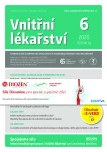Crystalopathy – underestimated entity in nephrology
Authors:
Petra Bachroňová; Ivan Rychlík
Authors‘ workplace:
I. interní klinika 3. LF UK a FN Královské Vinohrady Praha
Published in:
Vnitř Lék 2020; 66(6): 371-377
Category:
Overview
Crystal is a solid particle with a geometric shape because its atoms, ions, or molecules are arranged in a regular ordered structure. However, in case of accidental order of the particles, we are talking about the amorphous substances which can also form crystal‑like particles. Crystallopathy is a disease that involves crystals of crystal‑like particulate matter in the pathogenesis of tissue injury. Generally, several predominant pathophysiological mechanisms are involved in the formation of crystallopathies: necroinflammation, chronic remodeling of tissues leading to their atrophy and scarring, and obstruction of ducts, cavities or vessels by larger crystalline masses or stones. The basic distribution of crystallopathies in nephrology is as follows: renovascular crystallopathy (type 1), tubular crystallopathy (type 2), and finally urolithiasis (type 3) (tab. 1). Nowadays, the issue of crystallopathies in general medicine is omitted frequently not only among a wide range of professionals in the field of internal medicine but also in the field of specialists – nephrologists, urologist etc. One of the possible reasons may be the complexity and difficulty of grasping a wide‑ranging topic, so it is our intention to provide an overview of the latest findings and possible approaches to this problem.
Keywords:
tubulointerstitial nephritis – urolithiasis – hyperuricemia – cholesterol embolism – crystallopathy – oxalate
Sources
1. Mulay SR, Anders HJ. Crystal nephropathies: mechanisms of crystal‑induced kidney injury. Nat Rev Nephrol 2017; 13: 226–240.
2. Mulay SR, Anders HJ. Crystallopathies. N Engl J Med 2016; 374: 2465–2476.
3. Venturelli Ch, Jeannin G, Sottini L, et al. Cholesterol crystal embolism (atheroembolism). Heart Int 2006; 2: 155.
4. Herlitz LC, D‘Agati VD, Markowitz GS. Crystalline nephropathies. Arch Pathol Lab Med 2012; 136: 713–720.
5. Doshi M, Lahoti A, Danesh FR, et al. Paraprotein ‑Related Kidney Disease: Kidney Injury from Paraproteins ‑What Determines the Site of Injury? Clin J Am Soc Nephrol 2016; 11: 2288–2294.
6. Howard SC, Jones DP, Pui ChH. The Tumor Lysis Syndrome. N Engl J Med 2011; 364: 1844–1854.
7. Robijn S, Hoppe B, Vervaet BA, et al. Hyperoxaluria: a gut‑kidney axis? Kidney Int 2011; 80: 1146–1158.
8. Nazzal L, Puri S, Goldfarb DS Enteric hyperoxaluria: an important cause of end‑stage kidney disease. Nephrol Dial Transplant 2015; 31: 375–382.
9. van Slambrouck CM, Salem F, Meehan MM, et al. Bile cast nephropathy is a common pathologic finding for kidney injury associated with severe liver dysfunction. Kidney Int 2013; 84: 192–197.
10. Bosch X, Poch E, Grau JM. Rhabdomyolysis and acute kidney injury. N Engl J Med 2009; 361: 62–72.
Labels
Diabetology Endocrinology Internal medicineArticle was published in
Internal Medicine

2020 Issue 6
Most read in this issue
- Myocardial infarction or broken heart syndrome?
- Gastrointestinal tract involvement in mixed connective tissue disease (Sharp syndrome)
- Food allergy and intolerance
- Complement deficiencies
